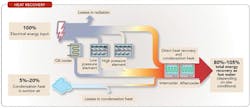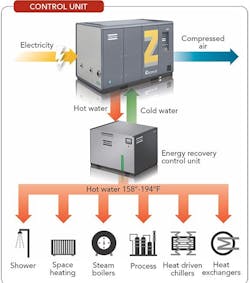Manufacturers face more-stringent mandates to restrict carbon dioxide emissions. Recovering the heat byproduct of compressed air is one step process plants can take to help reduce CO2 emissions and the risk of penalties for failing to meet emerging environmental standards. Doing so also will decrease total lifecycle cost.
In air compression, the electrical energy used to compress air is transformed into heat. However, it isn’t the only source of energy during air compression. Another important source is the humidity contained in the air entering the compressor inlet. Following compression, this humidity is condensed into liquid as the air is cooled in the intercooler and aftercooler. In the process of cooling this air, the latent heat of condensation is released into the cooling water. (The amount of latent heat of condensation depends upon the temperature and relative humidity of the intake air.)
The process of compressing the air includes several instances where heat is generated and transferred to the cooling water system. Some of the heat of compression passes to the cooling water around the compression elements via the element cooling jackets; a significant amount of heat is released to the coolers’ cooling water system. Additionally, the heat removed from the hot oil in the oil cooler is discharged into the cooling water system.
[callToAction]
The percentage of recoverable electical energy depends upon the compressor’s operating conditions. Intake air temperature, relative humidity, water temperature and pressure all play a role.
Some energy is lost through motor inefficiencies, via radiation of components such as the element and the cooler, and in residual heat and heat of condensation remaining in the outlet air.
Figure 1. Compression system suffers some minor energy losses but the vast majority of heat is recoverable.
If we combine all these factors in an overall view (Figure 1), the net result is that, for typical industrial conditions, we can recover 90–95% of the electrical input energy. And in specific conditions, recovering more than 95% is possible. An energy recovery system uses this energy to produce hot water.
Energy Recovery Basics
Compressors fitted with energy recovery technology feature a modified cooling water circuit to guarantee recovery of the largest possible amount of energy at the highest possible temperature. The cooling loop flows through the oil cooler, then through the compression elements’ jackets, and finally through coolers. The water that leaves a compressor with energy recovery can be as hot as 194˚F; the temperature can be regulated to meet process requirements.
A control unit specifically designed for energy recovery systems (Figure 2) can transfer the energy recovered while offering optimal protection of the compressor. The control unit is installed between the air compressor and the separate cooling water circuit, creating a completely independent and closed energy recovery circuit.
The energy recovery control unit can manage the recoverable energy and water flow of multiple compressors — up to its maximum limit for supplied energy. The unit often comes with several safety features, a de-aeration system, a pressure relief valve, and an expansion valve that controls the pressure in the water system.
The Impact Of Hardware
The type of compressor and the nature of its drive affect the amount of energy recoverable.
Oil-free screw compressors can recover more heat than any other type because they operate at much higher temperatures overall. Recovery of 90–95% of electrical energy input, and at some conditions even more, is possible.
Oil-lubricated screw units typically recover approximately 70% of the electrical input energy. Such compressors use oil as a coolant in the compression chamber to reduce the compression temperature. Therefore, less heat is recoverable than in oil-free units.
Centrifugal compressors operate at lower compression temperatures, limiting the amount of recoverable heat. For medium-pressure requirements, compression normally takes place in three stages; attempting to recover the energy from an interstage can create instability due to the dynamic compression principle. So, centrifugal compressors allow recovery of only about 30–35% of the energy.
Let’s now compare heat recovery for fixed-speed and variable-speed-drive (VSD) compressors. Constant water flow at a maximum temperature of 194°F is achievable from fixed-speed compressors, whereas the outlet temperature of VSD compressors will depend upon the load and may result in a maximum of up to 185°F. At minimum load, the output temperature for VSD compressors can drop to 140°F. As a rule of thumb, a fixed-speed unit can recover approximately 90–95% of the shaft power, whereas VSD compressors allow only about 75% recovery.
In cases where the installation must recover more energy and provide more hot water at higher temperatures for other processes, choosing a positive-displacement oil-free screw compressor is most advantageous.
Let’s look at an example. A 100-hp oil-free screw compressor with energy recovery of 95% will result in 95 hp of total heat recovered. Using 90% heat exchanger efficiency and $0.10/kWh cost for electricity, a compressor running 6,000 hours annually will achieve energy savings of around $43,372; this translates to a decrease in consumption of 434 MWh and a reduction of 260 metric tons of CO2. Generally, the payback for installing energy recovery systems is as short as two years.
Atlas Copco’s microsite “Use Your Energy Twice,” offers an energy savings calculator for estimating actual savings based on parameters such as power cost, running hours, boiler efficiency and more.
Compressor Performance
When weighing whether to install a heat recovery system, always consider its effect on compressor performance. To achieve maximum heat recovery, less cooling water flow passes through the circuit, increasing both the air-outlet and interstage temperatures, which can marginally de-rate the performance of the compressor. As a rule of thumb, the specific energy may rise by 3% while free air delivery could drop by 1.5%. Therefore, the outlet air temperature of a compressor with heat recovery also will be higher than that of a compressor without heat recovery.
Figure 2. Designed specifically for energy recovery, unit both manages energy transfer and protects the compressor.
It’s important to check with the vendor about compressor performance based on your input conditions. For instance, if the compressed air system includes a heat-of-compression dryer after the compressor, only 75% of the heat may be available to recover because some heat will be used for regenerating the desiccant in the dryer. Likewise, if the system recovers the heat from a VSD compressor, the hot water temperature will depend upon the load of the compressor, which can vary. Other factors to consider include how far the boiler house is from the compressor room, the rate of condensate recovery and the required process temperature. The size of the compressor also determines how much recoverable energy is available.
Make assumptions about specific flow rates of water at a particular temperature with care. Water available at 194°F may not meet flow requirements.
Consider, for example, a process needing 10 gal/min of hot water at 150°F from a 50-kW compressor with a cooling-water inlet temperature of 65°F. Assuming the recoverable heat is 95%, this translates to 48 kW (163,928 Btu/h).
Using the formula: heat transfer (Btu/h) = flow (gal/min) × temperature rise (°F) × K (a constant, K = 500 for water), the required Btu/h for 10 gal/min = 10 × (150-65) × 500 = 425,000 Btu/h, which far exceeds the heat recovery possible for a 50-kW unit. Therefore, the 50-kW compressor can’t provide 10 gal/min of hot water at 150°F.
If the process needs 10 gal/min from a 50-kW unit, the highest water temperature available actually will be the sum of the temperature rise and cooling water temperature. The temperature rise is: 163,928 Btu/h (heat recovered from 50-kW compressor)/(10 gal/min × 500) = 33°F. So, the highest water temperature is 33 + 65 = 98°F.
Looking at the calculation in a different way, the flow of 150°F water the 50-kW compressor can provide is 163,928 Btu/h/((150-65°F) × 500) = 3.85 gal/min.
You always should consider the tradeoff between the temperature of the water and its flow rate.
Many Possible Applications
Hot water from compressors suits a variety of process duties. For instance, it can serve as makeup water for steam systems — whether medium-pressure ones such as those used for reboilers and strippers or low-pressure ones that handle heat tracing, sterilization and other chores. It even can take care of space heating — just 100 kW of compressor heat can cover 1,000–2,000 m2 of factory.
Heat recovery from compressors can provide a huge positive impact on the environment. Companies should take advantage of heat recovery to enhance their green credentials, improve energy efficiency and reduce the lifecycle cost of the compressed-air system.
DEEPAK VETAL is product marketing manager, U.S. Oil Free Air Division, Atlas Copco Compressors, Rock Hill, S.C. E-mail him at [email protected].


